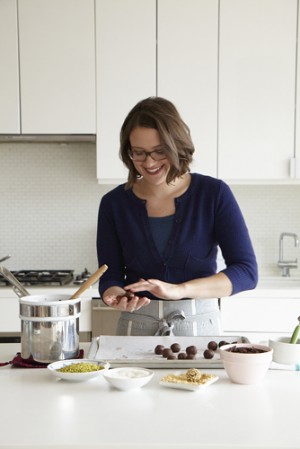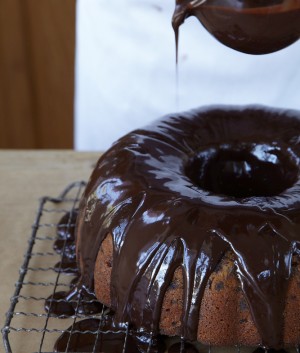Ganache—which calls for only two ingredients, heavy cream and bittersweet chocolate—is one of the easiest and most fundamental recipes in a pastry chef’s repertoire. Chop chocolate finely, add hot heavy cream, mix them together and voilà, you’re done!

While the concept for ganache is quite simple, there are a few basic principles you should know. Once mastered, you’ll find that the uses for ganache are nearly endless, providing plenty of room for creativity in the kitchen!
The Golden Ratios
The ratios listed below are for bittersweet chocolate, not for milk or white chocolate. Milk and white chocolate have a lot of added sugar and/or milk, which means they react in an entirely different way.
- For a chocolate sauce or a pourable glaze, use one part chocolate to two parts heavy cream.
- For a thicker cake glaze or a whipped cake filling, combine equal parts chocolate and cream.
- For a very thick ganache that you could scoop for chocolate truffles, combine two parts chocolate to one part heavy cream.
As you can see, the science is quite easy. If you want a thinner ganache, add more heavy cream. If you want a thicker ganache, add more chocolate.
When you consider the textures of the two ingredients at room temperature—chocolate is solid and heavy cream is liquid—it makes sense, right? Once you cool or chill your ganache, the texture will be entirely dictated by the ratio of cream to chocolate that you’ve used.
Choose Your Ingredients
The type of bittersweet chocolate you choose will have a direct effect on the texture and flavor of your ganache. Typically, the more simple a recipe is, the more important it is that you use the best quality ingredients you can find. Fine chocolates, like wine, have a variety of subtle and bold flavors layered within them. Some chocolate might have a bright and fruity flavor while others might have an earthy or smoky flavor.
Considering these subtle flavor qualities will make a big difference—particularly if you plan to make truffles, which are essentially a single bite of ganache. You should also consider the cocoa percentage in the chocolate used. The higher the percentage, the more cocoa solids are present in the chocolate. A higher percentage essentially indicates that less sugar is in the chocolate and vice versa for chocolate with lower percentages.
These percentages will affect the texture of your ganache. Like eating a bar of intense 80% chocolate versus a bar of 60% cocoa, the texture of a ganache made with darker chocolate will be more firm, whereas ganache made with lighter chocolate will be softer. Scientifically, this is because added sugar softens chocolate and acts like a liquid when chocolate melts.
As for the heavy cream, I recommend choosing a variety with the highest fat content possible. In grocery stores, most heavy cream has about 36% milk fat, but many professional kitchens opt for heavy cream with 40% milk fat. Higher milk fat content provides richer flavor, smoother texture and a more stable ganache. (Note: please do not be confused by “whipping cream.” It usually contains about 30% milk fat. While it can technically be used for ganache, the results are inferior.)

Key Techniques
There are a few key guidelines for preparing ganache, all of which are very easy to follow.
- Finely chop your chocolate. This allows the chocolate to melt more evenly, especially when making a thicker ganache that requires more chocolate than heavy cream.
- Bring the heavy cream to a simmer, not a full boil. It’s very easy to scorch heavy cream, so take care when heating it and stir frequently.
- Pour the hot cream over the chopped chocolate and let it sit for a few minutes. Ensure that the chocolate is fully submerged in the hot cream as it sits. This begins the melting process of the chocolate and makes mixing the two ingredients quick and easy.
- There are two ways to properly mix ganache:
- For a perfectly smooth ganache, use a rubber spatula to combine the two ingredients. This will take a bit more time but results in exceptional truffle fillings or smooth cake glazes that are absolutely air bubble-free.
- For a light, whipped ganache (used to frost a cake or as a cake filling), use a whisk. Whipping air into the ganache will also help it thicken and become more stable.
Add Extra Flavor
Ganache can be flavored with just about anything! Here are a few methods for developing your signature recipe.
- Infusion: Infuse the hot cream with herbs and spices like fresh lavender, rosemary or whole pink peppercorns. You can also steep tea leaves or coffee in your heavy cream.
- Incorporation: Add ground spices to the finished ganache, such as cinnamon or cayenne. Citrus zest, extracts or liqueurs are also fair game.
- Substitution: For a fruity spin on ganache, substitute some of the heavy cream for fresh fruit purée.
With these guidelines in mind, it’s up to you to experiment and discover what ganache preparations you like best. Try using a whisk and a spatula. Infuse flavor into your cream. Or simply play around with the ratio of chocolate to cream. Take copious notes when you do! You never know when you’ll make a batch that comes out just right.
Ready to master ganache and other essential techniques? Click here to learn more about ICE’s Pastry & Baking Arts program.



